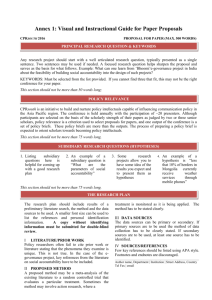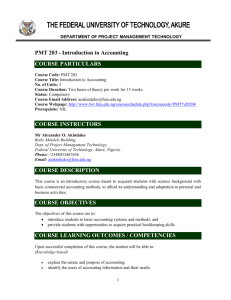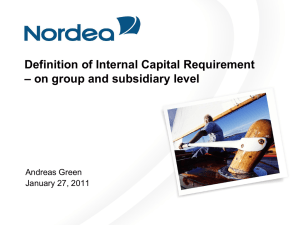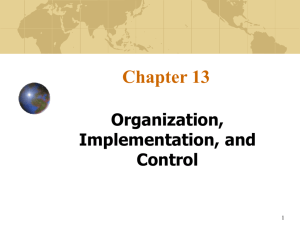Entrepreneurship in the Multinational Subsidiary
advertisement
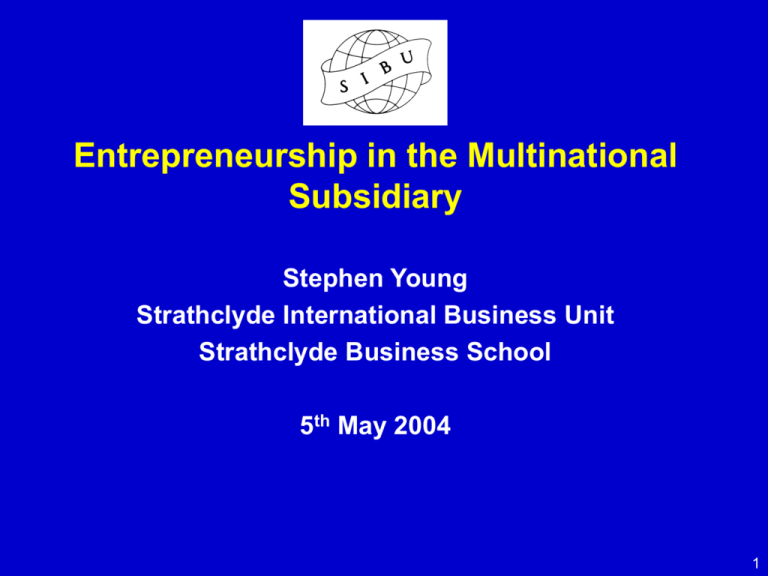
Entrepreneurship in the Multinational Subsidiary Stephen Young Strathclyde International Business Unit Strathclyde Business School 5th May 2004 1 The Development of Research on the Multinational Subsidiary Managing the Multinational • Headquarters-subsidiary relationships; centralization and decentralization • Strategy-structure; multinational integration and responsiveness • Networks and embeddedness Managing the Multinational Subsidiary • Subsidiary roles / strategies • Subsidiary mandates • Developing subsidiary roles / strategies Economic Development and Host Country Policy 2 Organising Framework for Subsidiary Development Parent company influences Head Office Assignment Decision made by head office managers regarding the allocation of roles/activities to the subsidiary Internal influences Subsidiary Choice Decisions by subsidiary managers regarding the roles/activities undertaken by the subsidiary Host company influences Subsidiary’s Role Measured in terms of the specific business, or elements of the business, which the subsidiary undertakes and for which it has responsibility Subsidiary Development Local Environment Determination Influence of environmental factors on decisions taken by head office and/or subsidiary managers regarding the roles/activities undertaken by subsidiary 3 Multinational Subsidiary Development – Conceptual Basis Three Perspectives 1. Head Office Assignment – Conceptual basis • Product life cycle model • Internationalisation process – Position in value added chain 2. Local Environment Determinism – Conceptual basis • Stages of economic growth • National competitive advantage 3. Subsidiary Choice – Conceptual basis • Network model of the MNC • Decision processes in complex organisations – Range of subsidiary types • Miniature replicas world product mandates 4. Subsidiary Development – Conceptual basis • As above plus RBV and dynamic capabilities perspectives 4 Definition of International Entrepreneurship International entrepreneurship is a combination of innovative, proactive and risk-seeking behaviour that crosses national borders and is intended to create value in organizations (McDougall and Oviatt, 2000). 5 Research Pertaining to Subsidiary Entrepreneurship • Subsidiary initiative: a form of corporate entrepreneurship involving: – Proactive and risk-taking behaviour – Use of resources beyond the control of the subsidiary – Acquisition and use of power and influence • Antecedents of an entrepreneurial orientation: – Autonomy and motivation – Role of entrepreneurial subsidiary executives – Constructiveness of parent-subsidiary relationships 6 Research Pertaining to Subsidiary Entrepreneurship (cont’d) • Entrepreneurship versus intrapreneurship in international business – Different risk-taking behaviour – Embeddedness in different institutional environments and resources • How to unleash innovation in foreign subsidiaries – Give seed money to subsidiaries – Use formal requests for proposals – Encourage subsidiaries to be innovative – Build international networks. 7 Subsidiary Entrepreneurship: Internal and External Competitive Forces and Subsidiary Performance (Birkinshaw, Hood and Young, International Business Review forthcoming 2004) • To explore the influence of the subsidiary’s competitive arena on subsidiary entrepreneurship and subsidiary performance • Subsidiary’s competitive arenas: – External competitive arena – external customers, suppliers, competitors – Internal competitive arena – customers, suppliers, competitors within the MNE 8 Internal and External Competitive Arenas High Competitiveness of external arena 3. Externallyfocused competitive environment (6) 4. Dual-focus competitive environment (6) 1. Benign environment (0) 2. Internallyfocused competitive environment (12) Low Low Competitiveness of internal arena High 9 Hypotheses Hypothesis 1: The more focused the subsidiary is on its external competitive arena (compared to its internal arena), the greater the degree of entrepreneurship (proxied by measures of autonomy, value-adding scope and level of upgrading). Hypothesis 2: The more focused the subsidiary is on its external competitive arena, the higher its performance. 10 Research Methodology • Qualitative research material based on case-study methodology. • 24 subsidiary companies in manufacturing in Scotland. • 2-7 interviews in each subsidiary: interview time 5-8 hours. Plus interviews with key suppliers and development partners, and reviews of case files held by public sector bodies. • Variables for internal and external environment derived from assessment of quantitative data on suppliers, customers and competitors; dependent variables based on scales derived from prior subsidiary research. 11 Results • Support for Hypothesis 1 Subsidiaries with internally-focused competitive environments rate substantially lower than other two groups on measures of entrepreneurial characteristics. • Moderate support for Hypothesis 2 Subsidiaries with internally-focused competitive environments have somewhat lower levels of performance. 12 Implications and Limitations • Issue of causality e.g. subsidiary may develop autonomy leading to relationships with suppliers and customers. • Relationships between subsidiary and its internal and external networks may be both competitive and collaborative. • Need to develop more holistic conceptualization and measurement of MNE subsidiary entrepreneurship. • Sample size and data limitations; also focus on manufacturing subsidiaries. 13 Multinational Subsidiary Entrepreneurship and Performance Associations in the UK: Contingency and Configurational Effects (ESRC-funded: Dimitratos, Young & Hood) Research Objectives • Which are the constituents of entrepreneurship in foreign-owned subsidiaries? • How does subsidiary entrepreneurship affect its performance? In particular: – To what extent is the subsidiary entrepreneurshipperformance association influenced by host country environmental variables? – To what extent is this association influenced by variables linked to the organisational context of the subsidiary? – To what extent is this association influenced by combinations of the two variable sets (‘host country environmental context’ and ‘organisational context of the subsidiary’)? 14 Conceptual Model of the Research Host Country (UK) environmental context Munificence Uncertainty Institutional profile Subsidiary entrepreneurial competencies Innovation propensity Risk attitude Market orientation Learning orientation Networking orientation Motivation Subsidiary performance in host country Micro / organisation-related • Sales change and market share change • Perceived mgt satisfaction relative to own/ headquarters’ expectations and to competitors Macro / host country-related • Perception of knowledge spillovers, mgt know-how transfer and company spinout Organisational context of the subsidiary Subsidiary management characteristics Subsidiary role Subsidiary autonomy Subsidiary credibility Headquarters-subsidiary communication 15


